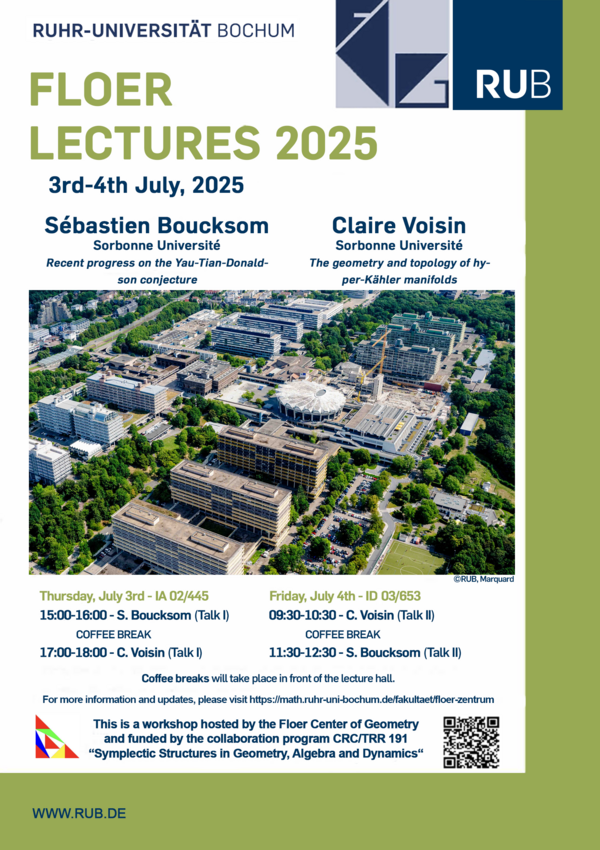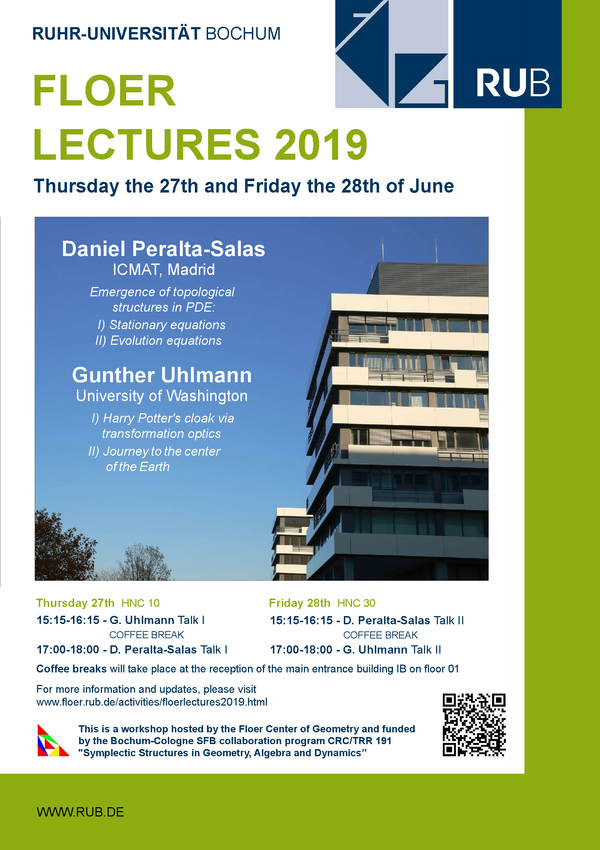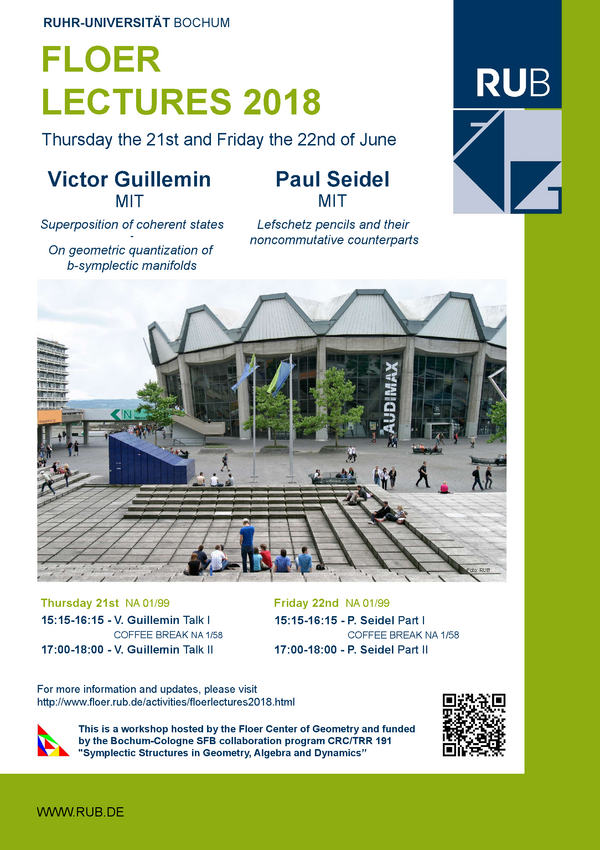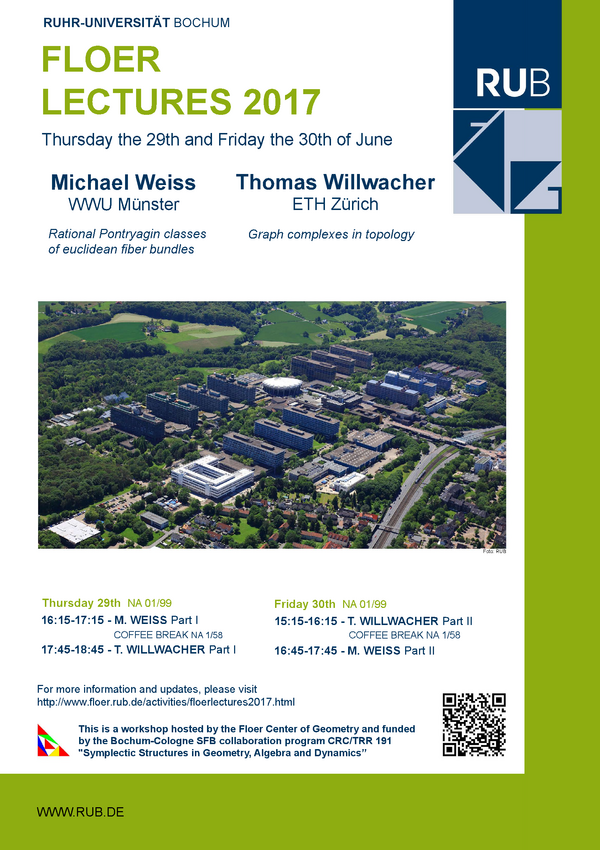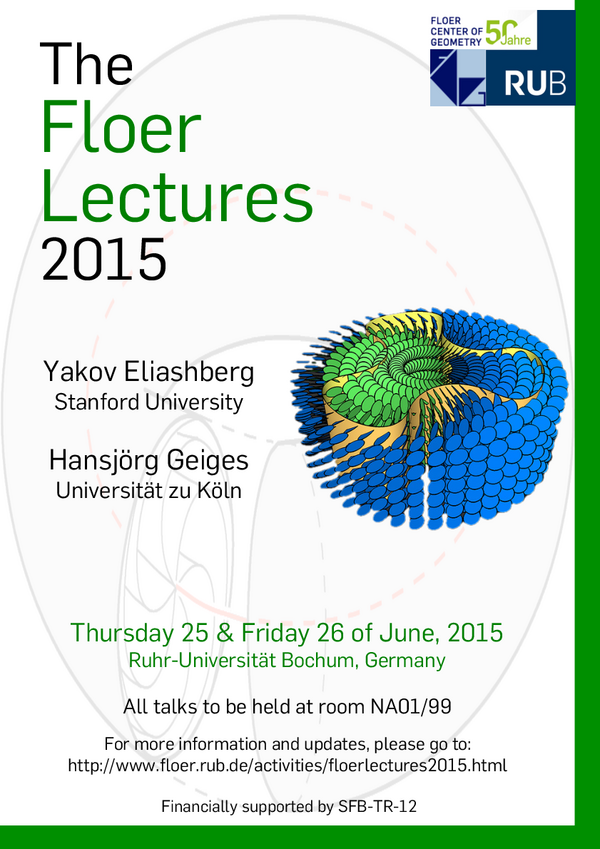Floer Lectures 2026
May 28-29, 2026, Bochum
We are delighted to have Sergey Fomin (Michigan) and Eleonore Faber (Graz) as our two speakers.
More information will follow soon.
(Kopie 2)
Anyone is welcome to attend!
There is no formal registration, but please send an email to Peter Tissen so that we can estimate the number of participants.
We hope to see you there!
Floer Lectures 2025
July 3-4, 2025, BOCHUM
We are delighted to have Sébastien Boucksom (Sorbonne Université) and Claire Voisin (Sorbonne Université) as our two speakers. They will each give two talks.
This is a workshop hosted by the Floer Center of Geometry and funded by the Bochum-Cologne-Heidelberg collaboration program CRC/TRR 191 "Symplectic Structures in Geometry, Algebra and Dynamics”.
The lectures will take place in the lecture hall ID 03/653. ----> Campus Map
SCHEDULE:
Thursday (ID 03/653)--->former IA 02/445
15:00-16:00 S. Boucksom - "Recent progress on the Yau-Tian-Donaldson conjecture"
16:00-17:00 Coffee break
17:00-18:00 C. Voisin - "The geometry and topology of hyper-Kähler manifolds"
Friday (ID 03/653)
09:30-10:30 C. Voisin - "The geometry and topology of hyper-Kähler manifolds"
10:30 - 11:30 Coffee break
11:30-12:30 S. Boucksom - "Recent progress on the Yau-Tian-Donaldson conjecture"
ABSTRACTS
Sébastien Boucksom - "Recent progress on the Yau-Tian-Donaldson conjecture"
The celebrated Poincaré-Koebe uniformization theorem is essentially equivalent to the existence of a canonical metric (of constant curvature) on any compact Riemann surface, i.e. any one-dimensional compact complex manifold. While a strict analogue of the uniformization theorem fails in higher dimensions, the search for canonical metrics on compact complex manifolds, and especially on projective manifolds, has been the source of a tremendous research activity. According to the Yau-Tian-Donaldson, the existence of canonical Kähler metrics in a given Kähler class should be equivalent to an algebro-geometric notion known as K-stability (in one of its guises). The case of Kähler-Einstein is by now well understood, and the more general case of constant scalar curvature (and even extremal) Kähler metrics seems within reach. The purpose of these lectures will be to provide a gentle introduction to this circle of ideas.
Claire Voisin - "The geometry and topology of hyper-Kähler manifolds"
Compact Hyper-Kähler manifolds are compact Kähler manifolds of very restricted holonomy type. They are complex manifolds that are symplectic in many ways, in particular holomorphic, and this is encoded by a quaternionic structure. In the first lecture, I will describe this geometry and explain some general topological properties satisfied by hyper-Kähler manifolds. In the second lecture, I will restrict to dimension 4 and sketch the proof of a classification result I obtained in collaboration with Debarre, Huybrechts and Macrì.
(Kopie 2)
Anyone is welcome to attend!
There is no formal registration, but please send an email to Herrn Tissen (Peter Tissen) so that we can estimate the number of participants.
We hope to see you there!
Floer Lectures 2024
June 20-21, 2024, BOCHUM
We are delighted to have Danny Calegari (University of Chicago) and André Neves (University of Chicago) as our two speakers. They will each give two talks.
This is a workshop hosted by the Floer Center of Geometry and funded by the Bochum-Cologne-Heidelberg collaboration program CRC/TRR 191 "Symplectic Structures in Geometry, Algebra and Dynamics”.
The lectures will take place in the lecture halls HZO 90 and IA 01/473. ----> Campus Map
SCHEDULE:
Thursday (HZO 90)
15:00-16:00 D. Calegari - "A new family of algebraic K(π,1)s I"
16:00-17:00 Coffee break
17:00-18:00 A. Neves - "Recent developments in minimal surfaces I"
Friday (IA 01/473)
09:30-10:30 A. Neves - "Recent developments in minimal surfaces II"
10:30 - 11:30 Coffee break
11:30-12:30 D. Calegari - "A new family of algebraic K(π,1)s II"
(Kopie 2)
Anyone is welcome to attend!
There is no formal registration, but please send an email to Frau Minzlaff (Corina Minzlaff) so that we can estimate the number of participants.
We hope to see you there!
Floer Lectures 2023
December 7-8, 2023, Bochum
We are delighted to have Alessio Figalli (ETH) and Gigliola Staffilani (MIT) as our two speakers. They will each give two talks.
This is a workshop hosted by the Floer Center of Geometry and funded by the Bochum-Cologne SFB collaboration program CRC/TRR 191 "Symplectic Structures in Geometry, Algebra and Dynamics”.
The lectures will take place in the lecture halls HIB and HZO 20. ----> Campus Map
SCHEDULE:
Thursday (HIB)
15:00-16:00 G. Staffilani - "A small window on wave turbulence theory I"
16:00-17:00 Coffee break
17:00-18:00 A. Figalli - "Quantitative stability in geometric and functional inequalities I"
Friday (HZO 20)
09:30-10:30 A. Figalli - "Quantitative stability in geometric and functional inequalities II"
10:30 - 11:30 Coffee break
11:30-12:30 G. Staffilani - "A small window on wave turbulence theory II"
ABSTRACTS:
G. Staffilani - "A small window on wave turbulence theory"
Wave turbulence theory is a vast subject and its goal is to formulate for us a global
picture of wave interactions. Phenomena involving interactions of waves happen at different
scales and in different media: from gravitational waves to the waves on the surface of the
ocean, from our milk and coffee in the morning to infinitesimal particles that behave like
wave packets in quantum physics. These phenomena are difficult to study in a rigorous
mathematical manner, but maybe because of this challenge mathematicians have developed
interdisciplinary approaches that are powerful and beautiful. I will describe some of these
approaches and show for example how the need to understand certain multilinear and periodic
interactions gave also the tools to prove a famous conjecture in number theory, or how
classical tools in probability gave the right framework to still have viable theories behind
certain deterministic counterexamples.
A. Figalli - "Quantitative stability in geometric and functional inequalities"
Geometric and functional inequalities play a crucial role in several problems in analysis and
geometry. The sharpness of a constant and the characterization of minimizers is a classical
and essential question. More recently, there has been a growing interest in studying the
stability of such inequalities. The basic question one wants to address is the following:
Suppose we are given a functional inequality for which minimizers are known. Can we
quantitatively show that if a function “almost attains the equality,” then it is close to one of
the minimizers?
In these lectures, I will first overview this beautiful topic and then discuss recent results
concerning the Sobolev, isoperimetric, and Brunn–Minkowski inequalities.
Floer Lectures 2022
October 6-7, 2022, Bochum
We are delighted to have Harald Andrés Helfgott (University of Göttingen) and Peter Scholze (Max Planck Institute for Mathematics) as our two speakers. They will each give two talks.
This is a workshop hosted by the Floer Center of Geometry and funded by the Bochum-Cologne SFB collaboration program CRC/TRR 191 "Symplectic Structures in Geometry, Algebra and Dynamics”.
The lectures will take place in the lecture hall HIA. ----> Campus Map
SCHEDULE:
Thursday
15:00-16:00 Harald Andrés Helfgott - "Expansion, divisibility and parity, I"
16:00-17:00 Coffee break
17:00-18:00 Peter Scholze - "Condensed Mathematics"
Friday
15:00-16:00 Peter Scholze - "Analytic Geometry"
16:00 - 17:00 Coffee break
17:00-18:00 Harald Andrés Helfgott- "Expansion, divisibility and parity, II"
Floer Lectures 2019
June 27-28, 2019, Bochum
We are delighted to have Daniel Peralta-Salas (ICMAT, Madrid) and Gunther Uhlmann (University of Washington) as our two speakers. They will each give two talks.
This is a workshop hosted by the Floer Center of Geometry and funded by the Bochum-Cologne SFB collaboration program CRC/TRR 191 "Symplectic Structures in Geometry, Algebra and Dynamics”.
Schedule:
Thursday
15:15-16:15 G. Uhlmann -"Harry Potter's Cloak via Transformation Optics"
16:15-17:00 Coffee break
17:00-18:00 D. Peralta-Salas - "Emergence of topological structures in PDE: stationary equations"
Friday
15:15-16:15 D. Peralta-Salas - "Emergence of topological structures in PDE: evolution equations"
16:15-17:00 Coffee break
17:00-18:00 G. Uhlmann -"Journey to the Center of the Earth"
Talks will take place on Thursday in room HNC 10 and Friday in HNC 30, which are located between the buildings NC and ND.
Coffee breaks will take place at the reception of the main entrance building IB, floor 01.
Abstracts:
D. Peralta-Salas - "Emergence of topological structures in PDE: stationary equations" & "Emergence of topological structures in PDE: evolution equations"
In recent years, new experimental methods and designs have enabled the observation and study of topological structures emerging from a wide range of physical phenomena, from fluid mechanics to electromagnetic theory. These structures take the form, for example, of knotted vortex tubes in fluid flows,
or knotted topological dislocations in optics and condensed matter theory. They provide a powerful visual tool to gain understanding of complex physical systems.
Mathematically, these physical processes are described by a vector or scalar field which satisfies a system of partial differential equations, and the emerging topological structures are instances of invariant sets of these fields. The understanding of which topological structures are compatible with the PDE constraint is a subtle problem which involves the interplay between dynamical systems, partial differential equations and differential geometry. The goal
of these lectures is to introduce the theory recently developed by Alberto Enciso and the speaker to address the study of these problems. Some of the questions that I will consider are: does there exist a steady Euler flow in Euclidean space having stream lines of all knot and link types? Can the nodal components of
a monochromatic wave exhibit arbitrary topology? Is there a solution to the heat equation with hot spots travelling along any prescribed spatial curve? How does the topology of a quantum vortex change accross reconnections? In the first lecture I will focus on the aspects of the theory for elliptic (time independent) PDE, while in the second part I will consider parabolic and dispersive evolution equations.
G. Uhlmann -"Harry Potter's Cloak via Transformation Optics"
Can we make objects invisible? This has been a subject of human fascination for millennia in Greek mythology, movies, science fiction, etc. including the legend of Perseus versus Medusa and the more recent Star Trek and Harry Potter. In the last fifteen years or so there have been several scientific proposals to achieve invisibility. We will introduce in a non-technical fashion one of them, the so-called "transformation optics" that has received the most attention in the scientific literature.
G. Uhlmann -"Journey to the Center of the Earth"
We will consider the inverse problem of determining the sound speed or index of refraction of a medium by measuring the travel times of waves going through the medium. This problem arises in global seismology in an attempt to determine the inner structure of the Earth by measuring travel times of earthquakes. It has also several applications in optics and medical imaging among other.
The problem can be recast as a geometric problem: Can one determine the Riemannian metric of a Riemannian manifold with boundary by measuring the distance function between boundary points? This is the boundary rigidity problem. We will also consider the problem of determining the metric from the scattering relation, the so-called lens rigidity problem. The linearization of these problems involve the integration of a tensor along geodesics, similar to the X-ray transform.
We will also describe some recent results, join with Plamen Stefanov and Andras Vasy, on the partial data case, where you are making measurements on a subset of the boundary. No previous knowledge of Riemannian geometry will be assumed.
Floer Lectures 2018
June 21-22, 2018, Bochum
We are delighted to have Victor Guillemin (MIT) and Paul Seidel (MIT) as our two speakers. They will each give two talks.
This is a workshop hosted by the Floer Center of Geometry and funded by the Bochum-Cologne SFB collaboration program CRC/TRR 191 "Symplectic Structures in Geometry, Algebra and Dynamics”.
Schedule:
Thursday
15:15-16:15 V. Guillemin - "Superposition of Coherent states"
16:15-17:00 Coffee break
17:00-18:00 V. Guillemin - "On geometric quantization of b-symplectic manifolds"
Friday
15:15-16:15 P. Seidel - "Lefschetz pencils and their noncommutative counterparts I"
16:15-17:00 Coffee break
17:00-18:00 P. Seidel - "Lefschetz pencils and their noncommutative counterparts II"
Talks will take place in room NA 01/99, which is on the ground floor of the Mathematics Department (building NA).
Coffee breaks will take place in the Friedrich-Sommer Raum NA 1/58, which is on the first floor up of the same building.
Abstracts:
P. Seidel - "Lefschetz pencils and their noncommutative counterparts"
Lefschetz' approach to understanding the topology of an algebraic variety was to consider its intersections
with a moving family of parallel hyperplanes. Such a family of intersections is called a "pencil", and those
with the mildest possible singularities are called "Lefschetz pencils". (The name may be puzzling now, but
pencil has an obsolete meaning as "paintbrush", in parallel with French "pinceau", and each intersection is thought of as a hair of that brush).
V. Guillemin - "Superposition of Coherent states"
We will show in this talk how one can construct solutions of semi-classical partial differential equations such as, for instance, the Schroedinger equation by expressing the initial data as superpositions of coherent states and then solving these equations with these coherent states as initial data. (The virtue of doing this is that these coherent state solutions have nice geometric properties. For instance, for the Schroedinger operator associated with a Riemann metric on curved space-time their singularities are concentrated on single closed geodesics of the metric.)
V. Guillemin - "On geometric quantization of b-symplectic manifolds"
In the first part of this lecture we will review what's known about actions of tori on Poisson manifolds and discuss some of the problems one encounters in attempting to quantize such actions. Then in the second part we will show how this can be done in one important case by converting the Poisson bi-vector field into a symplectic form that blows up along a b-hypersurface.
We hope to see you there!
Floer Lectures 2017
June 29-30, 2017, Bochum
We are delighted to have Michael Weiss (Münster) and Thomas Willwacher (ETH Zürich) as our two speakers. They will each give two talks.
This is a workshop hosted by the Floer Center of Geometry and funded by the Bochum-Cologne SFB collaboration program CRC/TRR 191 "Symplectic Structures in Geometry, Algebra and Dynamics”.
Abstracts:
T. Willwacher - "Graph complexes in topology"
Graph complexes are vector spaces of formal linear combinations of combinatorial graphs, with a
differential, and often further algebraic structure.
Following seminal work of Kontsevich and others it has been found in recent years that many
questions of topological interest can be reduced to questions about graph complexes and can hence to a certain degree be combinatorialized.
I will give a general overview about graph complexes, the state of the art, and their appearance in algebra and topology.
Furthermore, I will report on recent work with B. Fresse and V. Turchin in which we (mostly) settle the rational homotopy theory of the little n-disks operads, by showing that they are intrinsically formal for n>=3, and by computing the rational homotopy type of the function spaces between these operads.
As an application we obtain completely combinatorial (graphical) descriptions of the spaces of long embeddings of R^m into R^n in codimension >=3.
M . Weiss - "Rational Pontryagin classes of euclidean fiber bundles"
A euclidean fiber bundle is a fiber bundle with fiber Rn for some n. It may be helpful to think of euclidean vector bundles as something like real vector bundles, but without the linear structure. Real vector bundles have certain characteristic classes, the Pontryagin classes; the Pontryagin classes of a real vector bundle are essentially the Chern classes of the complexified vector bundle. In the late 1950s and early 1960s it emerged that the Pontryagin classes of a real vector bundle do not depend on the linear structure, as long as we use cohomology with rational coefficients. In other words, euclidean fibers bundles have (rational) Pontryagin classes, too. Nowadays we can state this rather easily by saying that the classifying space for stable euclidean fiber bundles, BTOP, has the same rational cohomology as the classifying space for stable vector bundles, BO. But this does not do justice to the process of discovery.
The old definition of Pontryagin classes for real vector bundles in terms of complexification and Chern classes implies some vanishing relations. Specifically, the Chern class ck (in 2k-dimensional cohomology) of an n-dimensional complex vector bundle vanishes if k > n, so that the Pontryagin classes in cohomological dimension > 2n of an n-dimensional real vector bundle are also zero. But the definition of rational Pontryagin classes for euclidean fiber bundles does not use complexification. (Complexification of euclidean fiber bundles does not seem to make any sense!) Instead it is inspired by the Hirzebruch signature theorem which expresses the signature of a smooth closed manifold in terms of the Pontryagin classes of its tangent bundle (and this can also be read the other way round). Therefore the question arises: do the rational Pontryagin classes of euclidean fiber bundles satisfy the same vanishing relations, i.e., do they always vanish in cohomology of degree > 2n if the fiber dimension is n? It turns out that this is not the case. The counterexamples available so far are more statistical in nature than explicit, and they are not claimed to be best or worst possible, but in any case one can go nearly as far cohomological dimension equal to 9/2 times the fiber dimension n and still see nonzero rational Pontryagin classes, provided n is large enough.
The construction of these (counter)examples takes us back to the Hirzebruch signature theorem. Apart from that it exploits recent advances in the homotopical theory of diffeomorphism groups of highly connected manifolds (especially the work of Galatius and Randal-Williams), and advances in the homotopical theory of spaces of smooth embeddings which in turn lead to the construction of interesting families of homeomorphisms.
Anyone is welcome to attend!
There is no formal registration, but please send an email to Frau Dzwigoll (ursula.dzwigoll@rub.de) so that we can estimate the number of participants. Everyone is welcome to join us for a dinner on the Thursday evening.
Hotels
Here are some of the hotels in Bochum, please contact Frau Dzwigoll if you would like assistance with booking a room.
Park Inn - conveniently located next to central station, large rooms, but not cheap (ca 85 Euro incl. breakfast)).
Ibis City und Ibis Zentrum - next to central station, small rooms, good price but nothing special - Ibis Zentrum is probably a bit more quiet (ca 65 incl. breakfast).
Art Hotel Tucholsky in the "Bermuda triangle" (party mile), that is, can be noisy at night, but if you reserve a room to the back yard it's very fine, art hotel with funny accessoires - great breakfast, probably the most interesting hotel in the list (ca. 75 Euros incl. breakfast)
Jugendherberge (youth hostel) Bochum again in the "Bermuda triangle", it is supposed to be very good and has differnet kinds of rooms (ca. 62 Euros for single rooms incl. breakfast)
General directions including a map of the campus can be found here.
For assistance or questions please contact Ursula Dzwigoll.

Floer Lectures 2016
June 23-24, 2016, Bochum
We are delighted to have Ralph Cohen (Stanford University) and Thomas Kragh (Uppsala University) as our two speakers. They will each give two talks.
This is a workshop hosted by the Floer Center of Geometry.
Schedule:
Thursday
16:15-17:15 R . Cohen - "Calabi Yau categories, the string topology of a manifold, and the Floer theory of its cotangent bundle I"
17:15-17:45 Coffee break
17:45-18:45 T. Kragh - “The Legendre Transform, Symplectic homology, and stable homotopy types I"
Friday
11:15-12:15 T. Kragh - “The Legendre Transform, Symplectic homology, and stable homotopy types II"
12.30-14.00 Lunch at the Mensa
14:15-15:15 R. Cohen - "Calabi Yau categories, the string topology of a manifold, and the Floer theory of its cotangent bundle II"
Talks will take place in room NA 02/99 on Thursday and in room NA 01/99 on Friday, which are both on the ground floor of the Mathematics Department (building NA).
Coffee breaks will take place in the Friedrich-Sommer Raum NA 1/58, which is on the first floor up of the same building.
Abstracts:
R. Cohen - "Calabi Yau categories, the string topology of a manifold, and the Floer theory of its cotangent bundle"
T. Kragh - “The Legendre Transform, Symplectic homology, and stable homotopy types"
In the first talk I will go over the basics of: Morse theory and Loop space homology. I will then describe the Legendre transform and how this relates to the notion of symplectic homology. I will in particular try and give a description of why one would expect an isomorphism between the loop space homology (with some orientation) and symplectic homology. This isomorphism was first proven by Viterbo, and later generalized and proved differently by both Salamon and Weber, and Abbondandolo and Schwarz.
In the second talk I will go into more details on symplectic homology and sketch how to define a spectrum (stable homotopy type) representing it. That such a spectrum exists was proven earlier by Cohen, Segal and Jones; but I will give an explicit construction, which works functorially (Viterbo functoriallity). This construction uses finite dimensional approximations of loop spaces and the Legendre transform. I will then outline some consequences that this has, which seems intractable to prove using the homological versions alone.

Floer Lectures November 2015
November 13th 2015, Bochum
Stefan Nemirovski (Steklov Institute, Moscow and Ruhr Universität Bochum) speaks on "Spacetimes and contact topology."
The two one-hour lectures start at 11:15 and at 14.15 in room NA 6/99.
Floer Lectures June 2015
June 25-26, 2015, Bochum
We are delighted to have Yakov Eliashberg (Stanford University) and Hansjörg Geiges (Cologne University) as our two speakers. They will each give two talks.
This is a workshop hosted by the Floer Center of Geometry and financially supported by SFB TR-12.
Schedule:
Thursday
16.15-17.15 H. Geiges - "Topological aspects of Reeb dynamics I"
17:15-17.45 Coffee break
17.45-18.45 Y. Eliashberg - “Towards the frontier of symplectic flexibility I”
Friday
16.15-17.15 Y. Eliashberg - “Towards the frontier of symplectic flexibility II”
17:15-17.45 Coffee break
17.45-18.45 H. Geiges - "Topological aspects of Reeb dynamics II"
Talks will take place in room NA 01/99, which is on the ground floor of the Mathematics Department (building NA).
Coffee breaks will take place in the Friedrich-Sommer Raum NA 1/58, which is on the first floor up of the same building.
Dinner: there will be a group dinner on the Thursday evening at Yamas mezé Restaurant, Massenbergstr. 1, 44787 Bochum. Please send an email to Frau Dzwigoll (ursula.dzwigoll@rub.de) or to Barney Bramham(barney.bramham@rub.de) if you think you will join.
Abstracts:
H. Geiges - "Topological aspects of Reeb dynamics"
In my lectures I shall review joint work with Kai Zehmisch on Reeb dynamics, concerning the interplay between topology and the existence of periodic Reeb orbits. The emphasis will lie on surgical constructions and cobordism-theoretic aspects.
Y. Eliashberg - “Towards the frontier of symplectic flexibility”
Flexible and rigid methods coexisted in symplectic and contact topology since its inception more than 30 years ago.
Till recently rigid methods (Gromov’s theory of holomorphic curves, Floer homology etc) dominated the development of the subject. However, in the last 3 years several new unexpected discoveries were made on the flexible side.
In the lectures I will describe the history of the struggle between symplectic rigidity and flexibility, which shaped the development of the subject, and will describe the recent advances in symplectic flexibility.

Floer Lectures 2014
June 13-14, 2014, Bochum
Invited speakers:
1. Claude Viterbo (Ècole Normale Supérieure, Paris) - Symplectic distance, homogenization and symplectic dynamics.
2. Frol Zapolsky (University of Haifa, Israel) - Generating functions and applications in contact topology.
All the lectures will take place in the lecture room NA 01/99, on the ground floor of the Mathematics Department (Building NA).
Participation is open.
General directions can be found here. A campusmap, as well as other useful maps, can be found here.
The workshop is hosted by the Floer Center of Geometry and is financially supported by SFB TR-12.
Schedule:
Friday
3.15-4.15 pm: C.Viterbo - Symplectic distance, homogenization and symplectic dynamics (NA 01/99)
4.15-5.15 pm: Coffee break
5.15-6.15 pm: F.Zapolsky - Generating functions and applications in contact topology I (NA 01/99)
Saturday
10-11 am: F. Zapolsky - Generating functions and applications in contact topology II (NA 01/99)
11-11:30 am: Coffee break
11:30-12:30 am: C. Viterbo - Symplectic distance, homogenization and symplectic dynamics (NA 01/99)
Abstracts
C. Viterbo - Symplectic distance, homogenization and symplectic dynamics.
TBA.
F. Zapolsky - Generating functions and applications in contact topology.
I'll introduce the powerful technique of generating functions for Legendrian submanifolds of certain standard contact manifolds and show how to use it to prove intriguing results on rigidity in contact manifolds and dynamics of contact flows. I'll provide the necessary background for the concepts and techniques used in the lectures.

Floer Lectures 2013
April 19-20, 2013, Bochum
All talks are in building HZO, room HZO 60, Ruhr-Universität Bochum.
Travel information and Plan of the University.
Talks
Speaker: Prof. Dr. Kai Cieliebak (Universität Augsburg)
Title: Rabinowitz Floer Homology
Abstract: Floer's original homology is the semi-infinite dimensional Morse homology of the action functional of classical mechanics, whose critical points are periodic orbits of a Hamiltonian system of fixed period. Rabinowitz Floer homology is a variant of this construction based on the Rabinowitz action functional, whose critical points are periodic orbits of fixed energy. It turns out to be closely related to dynamical questions such as stability and Mane's critical values, as well as to questions in contact and symplectic topology.
Speaker: Prof. Dr. Alexander F. Ritter (University of Oxford)
Title: Floer theory for negative line bundles
Abstract: Let E be a negative line bundle over a symplectic manifold. I will explain how the Gromov-Witten theory determines the symplectic cohomology of E. I will then talk about joint work with Ivan Smith on how the symplectic cohomology determines the wrapped Fukaya category when E is a negative line bundle over projective space. More concretely, this involves the existence of a non-displaceable monotone Lagrangian torus in E.
Schedule of talks
Friday, April 19 | ||
15:00 | Opening |
|
15:15 - 16:15 | Kai Cieliebak | Rabinowitz Floer Homology I |
16:15 - 17:15 | Tea/Coffee break |
|
17:15 - 18:15 | Alexander F. Ritter | Floer theory for negative line bundles I |
Saturday, April 20 | ||
09:15 | Alexander F. Ritter | Floer theory for negative line bundles II |
10:15 - 11:15 | Tea/Coffee break | |
11:15 - 12:15 | Kai Cieliebak | Rabinowitz Floer Homology II |
Organizers: Alberto Abbondandolo

December 07, 2011, Bochum
The opening of the FCG is celebrated with a festive colloquium on December 07 2011 in the Veranstaltungszentrum of the RUB. At 2 pm there is a celebration of the graduates of the faculty with coffee and tee. The opening of the Floer Centre starts at 3 pm. The main speakers are Helmut Hofer (Princeton), Stefan Nemirovski (Steklov) and Andrew Ranicki (Edinburgh). (Unfortunately, S. Novikov had to decline his talk for health reasons.) The talks will be continued on the following day. The event is financially supported by the DFG GRK 1150 and the Research School RUB, especially since it addresses graduate students and young post-docs.
All talks are in the Veranstaltungszentrum Saal 2a/ Saal 3 Ruhr-Universität Bochum. The Veranstaltungszentrum is in the new Mensa Building Floor 04. You can park in P9 under the audimax building and follow the signs.
Travel information and Plan of the University.
Schedule of talks
Wednesday, December 07 | ||
15.00 - 15:10 | Gerd Laures | Introduction to the FCG |
15:10 - 15:30 | Siobhan Roberts | The person Andreas Floer |
15:30 - 16:30 | Helmut Hofer | From Symplectic Geometry to Symplectic Dynamics I |
| coffee break |
|
17:00 - 18:00 | Andrew Ranicki | The Poincare duality theorem and its converse I |
18:00 - 19:00 | Stefan Nemirovski | Complex analysis and symplectic topology I |
| dinner/buffet |
Thursday, December 08 | ||
10.00 - 11:00 | Helmut Hofer | From Symplectic Geometry to Symplectic Dynamics II |
11.00 - 12:00 | Andrew Ranicki | The Poincare duality theorem and its converse II |
lunch break |
| |
14:00 - 15:00 | Stefan Nemirovski | Complex analysis and symplectic topology II |

